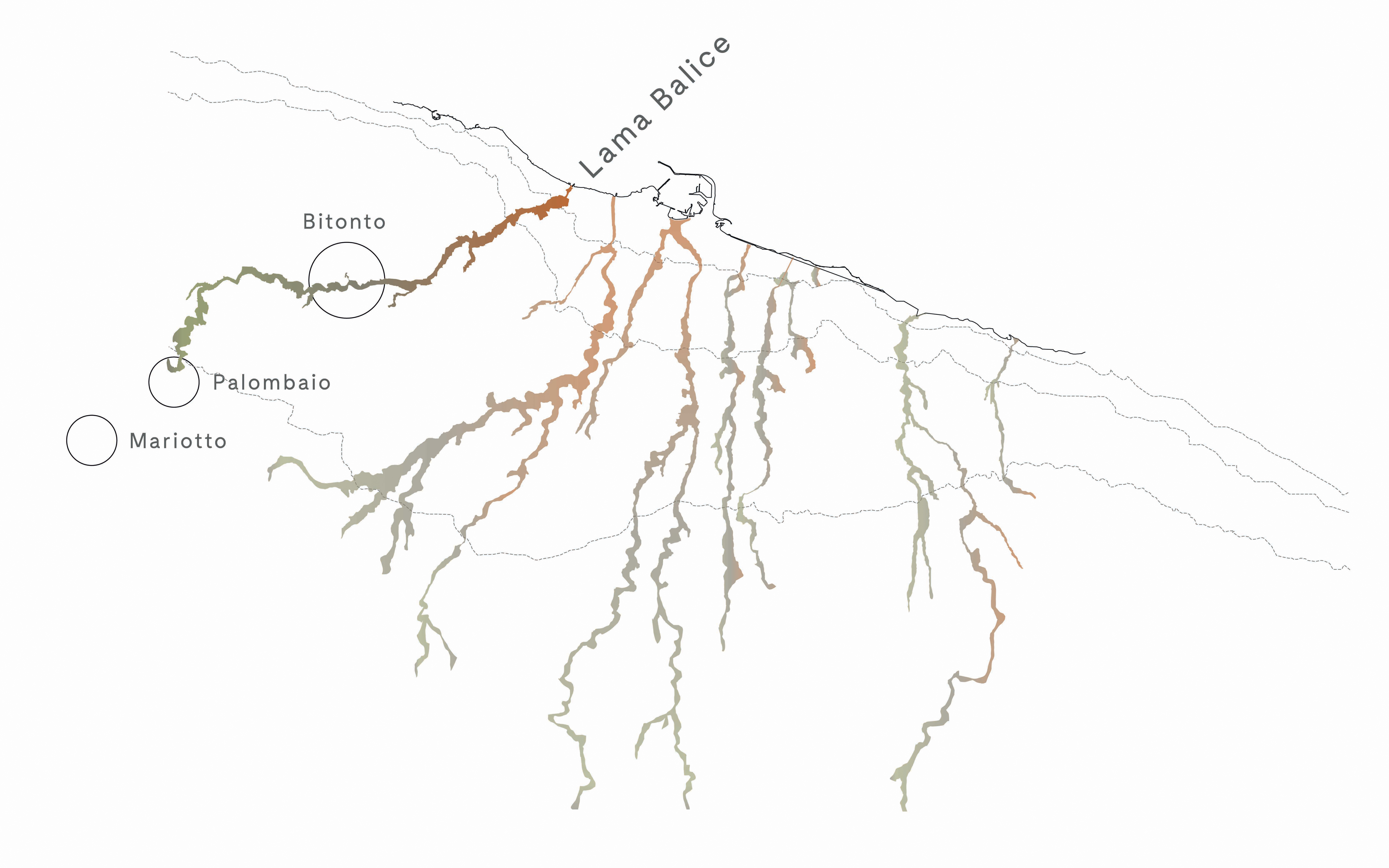LEARNING FROM THE LAMA
Europan 16 - Bitonto (IT)
Winner project
Year: 2021
Team: Luca Luini, Riccardo Masiero
Location: Bitonto (BA), Italy
Status: Competition - First Prize
The need to regenerate Bitonto itself in the light of the challenges of the Anthropocene is possible through an enhancement of the functioning of its three main scopes: the urban scope, the agricultural scope, and the naturalistic scope of Lama Balice. The latter is the one whose potential currently is the least developed. The analysis of the natural mechanisms existing within the Lama and the study of its complex biology generate exchange models that, once implemented and replicated, could contribute to reinforcing the biodiversity with positive effects on environmental quality, urban livability, and economic processes. The piazzas of Bitonto, Palombaio, and Mariotto would then become the physical places where these regenerative processes would take place on a human scale.

An important geological characteristic of the area is presence of the “Lame": long and shallow karst furrows that cross the plain of Bari from the Murgia hills to the coastline. The “Lame” constitutes a major exception in the agricultural landscape of the Apulian plateau, which is normally dominated by olive and wine cultivation, representing natural ecologic corridors for the wild species of the area.

In the management of the
transformation of the territory Bitonto presents three
different grounds of change:
•City
(urban scope): the space of the consolidated city of Bitonto and the two
outposts of Palomabio and Mariotto;
•Lama
(naturalistic scope): the space of major naturalis tic quality and
biodiversity;
•Ruralscape
(agricultural scope): the ordinated space of the olive plateau and its places of production.

Lama
Balice is a puzzle of diverse and various biotopes, especially if compared to
the surrounding agricultural land. Along its path, Lama Balice varies in width
and depth, as well as in the presence of water and land usage. The result of
this fragmentation is a richness in biodiversity and landscapes that gave to
the lama an exceptionality that still needs to be valorized in a proper way.


The
implementation of virtuous exchanges between the three scopes generates
dynamics that can be condensed in local interventions. The theme “reinforce
biodiversity” to transform Bitonto is interpreted through the analysis of the mechanisms
that regulate e the territory, developing processes between the places
of changes, and their reference contexts. The loss of biodiversity of
the Antropocene transformation is evident in the disfunction of the ecosystems,
in the loss of those ecological services and goods that are no more furnished by the land, and in the loss of
complexity of genetic diversity.
Bitonto.
The system of the squares of Bitonto can be seen as an urban breach in the compact urban fabric of the city. The open space of the squares follows an inclined plane that slowly descends from piazza Aldo Moro to piazza Castello, facing onto Lama Balice.


The project intends to revitalize the pulsing heart of the city facing the actual problems while preserving the identity and the genius loci of Bitonto center. The approach of the project is the preserving of the main spatial features of the place but with a new approach to the theme of the biodiversity and quality of urban life.

Palombaio, Mariotto.
![]()


The hamlets of Bitonto are situated in the vast olive plain surrounding the city, born and de veloped as rural outposts for the city . The main squares of the hamlets are located alongside this road, as are the main civic and religious building of the towns.
The promotion of
itineraries to visit the agricultural areas and
the inland area of Bitonto can generate a virtuous development
of the economy
of the hamlets. Particularly, the Via Cela bike lane that connects Bitonto with Alta Murgia
National Park crosses the north
area of the two hamlets:
the goal is to intercept
the fluxes of
people visiting the
countryside by proposing
them as intermediate stops
in the discovery of the
territory, and to establish contacts between local product companies and
outside visitors. This process can be fixed in the squares of the hamlets,
regenerating them and the activities surrounding it.



